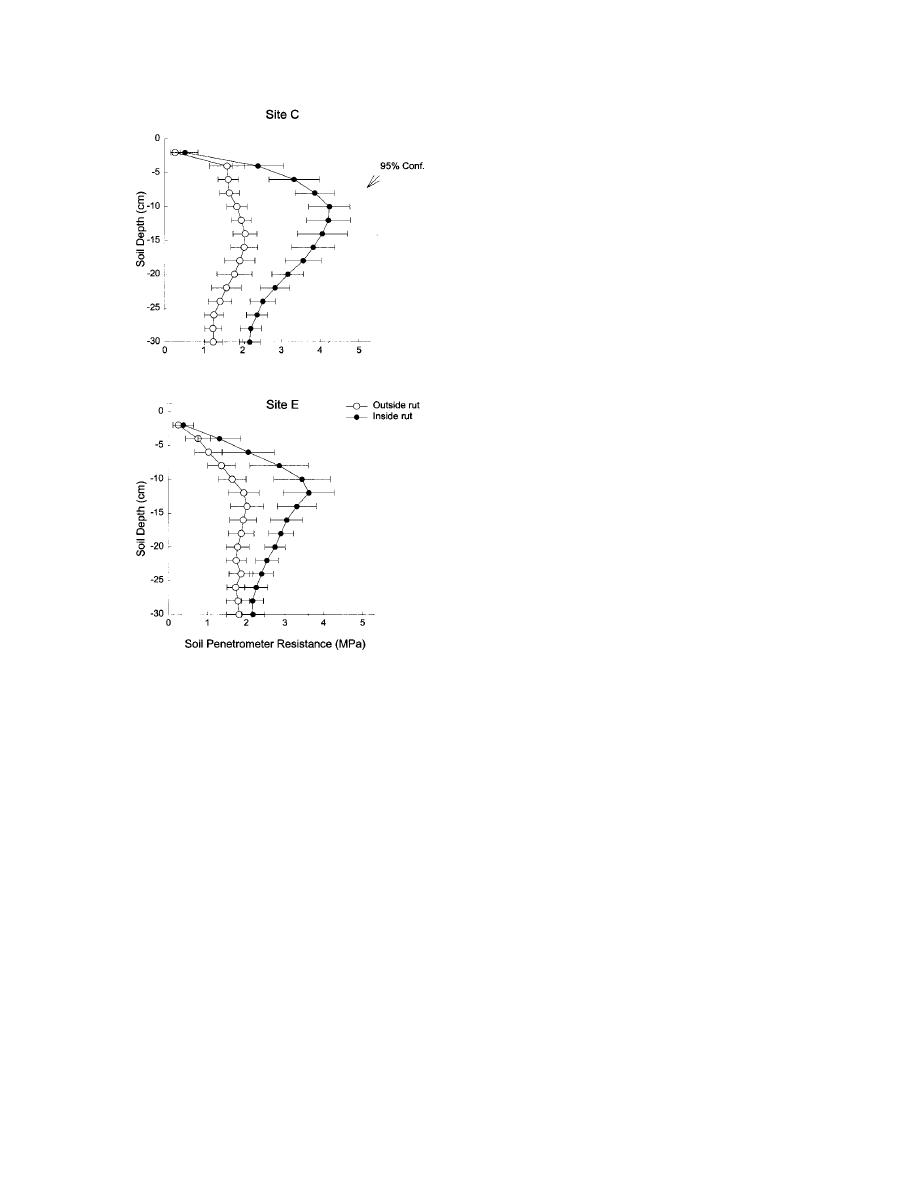
than about 3 MPa (e.g., Taylor and Burnett 1964,
a.
Gerard et al. 1982), establishment of new seed-
lings in tank ruts may be impacted.
The average SPR profiles for each plot (Fig. 12)
were useful for summarizing data and for statis-
tical comparison between sites but did not reveal
details about intersite variability. Some individual
locations, within the sites, showed little change
with depth or difference between rutted and uncom-
pacted soil (App. D). Further, while we observed
maximum average SPRs at 1015 cm depth in
both sites, turning ruts at site E exhibited simple
increasing SPR with depth (App. D).
Average SPR profiles, delineated simply as
inside or outside of ruts, also did not reveal details
of spatial variability such as would be encountered
b.
in the field. Figure 13 shows a series of SPR pro-
files, measured every 15 cm across both ruts at
T-2 of site E (see Fig. 4). It shows how SPR can vary
greatly with small increments of depth or across
short distances of the rutted landscape. The high-
est SPR values mark the location of the ruts where
the compaction extends to 20 cm or more in depth.
The uncompacted soil outside and between the
ruts exhibits lower SPRs.
Bulk density
Data indicate that changes in soil bulk density
due to vehicle compaction are affected by soil
water content at the time of traffic and depth of
measurement. Soil bulk density, both inside and
Figure 12. Average soil penetrometer resistances
outside a straight, dry soil rut at site C, were about
95% confidence intervals for profile locations
1.3 g cm3 throughout the entire sampling depth
(n = 17 [site C], 18 [site E]).
(Fig 14a). The uncompacted soil, outside a
straight rut created on moist soil, also had an
average bulk density of about 1.3 g cm3, but con-
sistently higher bulk densities were observed at
increased significantly to maximum values
all depths greater than 2.5 cm inside the rut (Fig
between 10- to 15-cm depth, and then decreased
14b). Measurements for a single-pass turning rut,
significantly with depth at site C (Fig. 12). How-
revealed a similar, though less pronounced, pat-
ever, at E the average SPR in unrutted soil did
tern with the greatest differences between rutted
not decrease significantly with depth below the
and uncompacted soil observed between 10- to
maximum.
20-cm depth (Fig 14c). We observed little differ-
More force is required to penetrate the soil in
ence between rutted and uncompacted soil at site
tank ruts than in adjacent uncompacted soil
C near the soil surface (2.5 cm).
except near the soil surface. Average SPR was
Average bulk density outside straight ruts at
site E was about 1.1 g cm3 and showed little
significantly greater inside ruts than outside ruts
at all depths below 5 cm at site C and at depths
change with depth (Fig. 14d). In comparison, bulk
between 7.5 and 22.5 cm at site E (Fig. 12). SPR
density inside the adjacent rut, created on moist
soil, was consistently higher (about 1.4 g cm3).
reached a maximum average value of about 4.0
MPa inside ruts, compared to about 2.0 MPa out-
Bulk density was greater in a turning rut at depths
side the ruts at both sites. Since plant roots may
above 15 cm, but it was greater in the uncompact-
have difficulty penetrating soil at SPRs greater
ed soil below 25-cm depth (Fig. 14e).
10



 Previous Page
Previous Page
